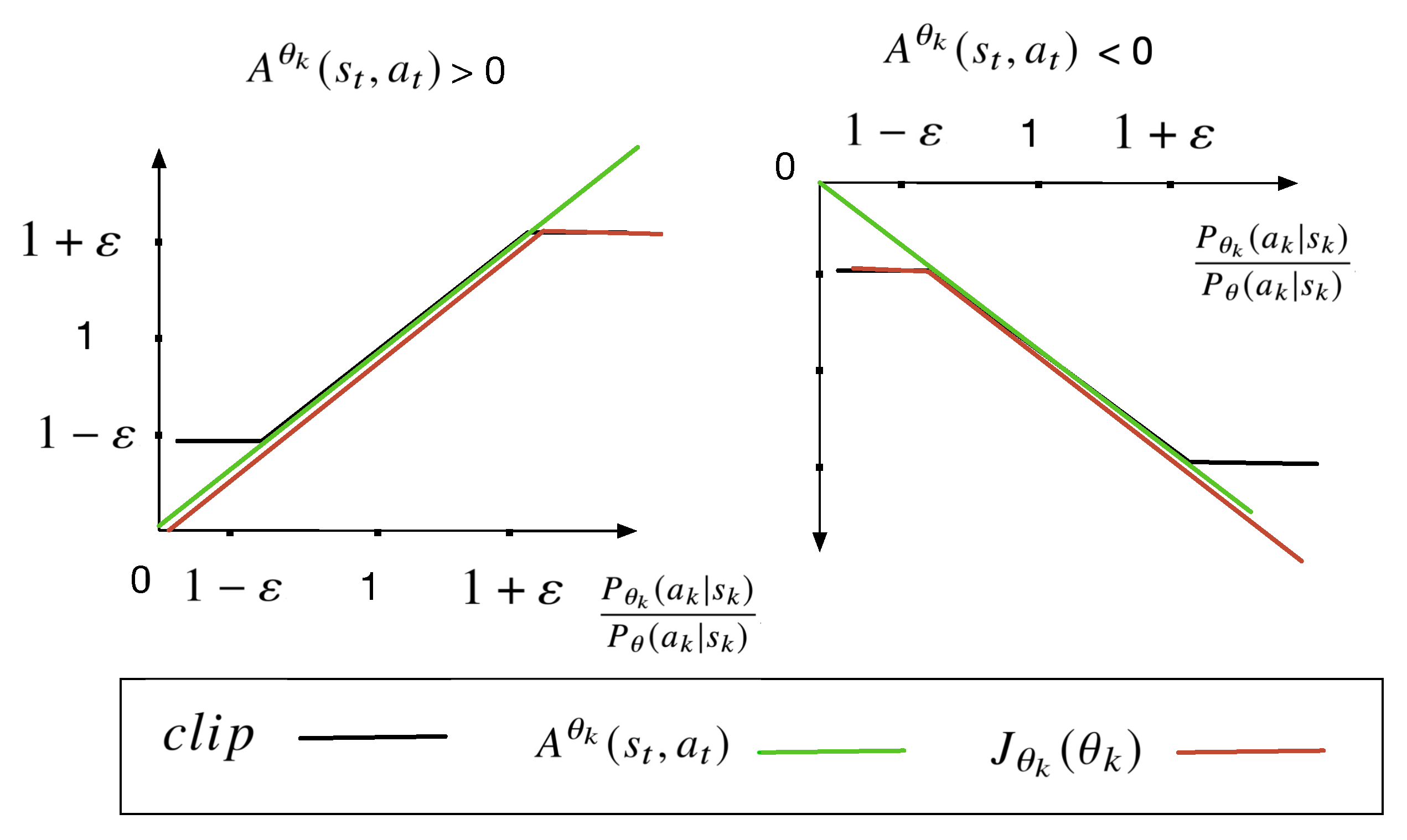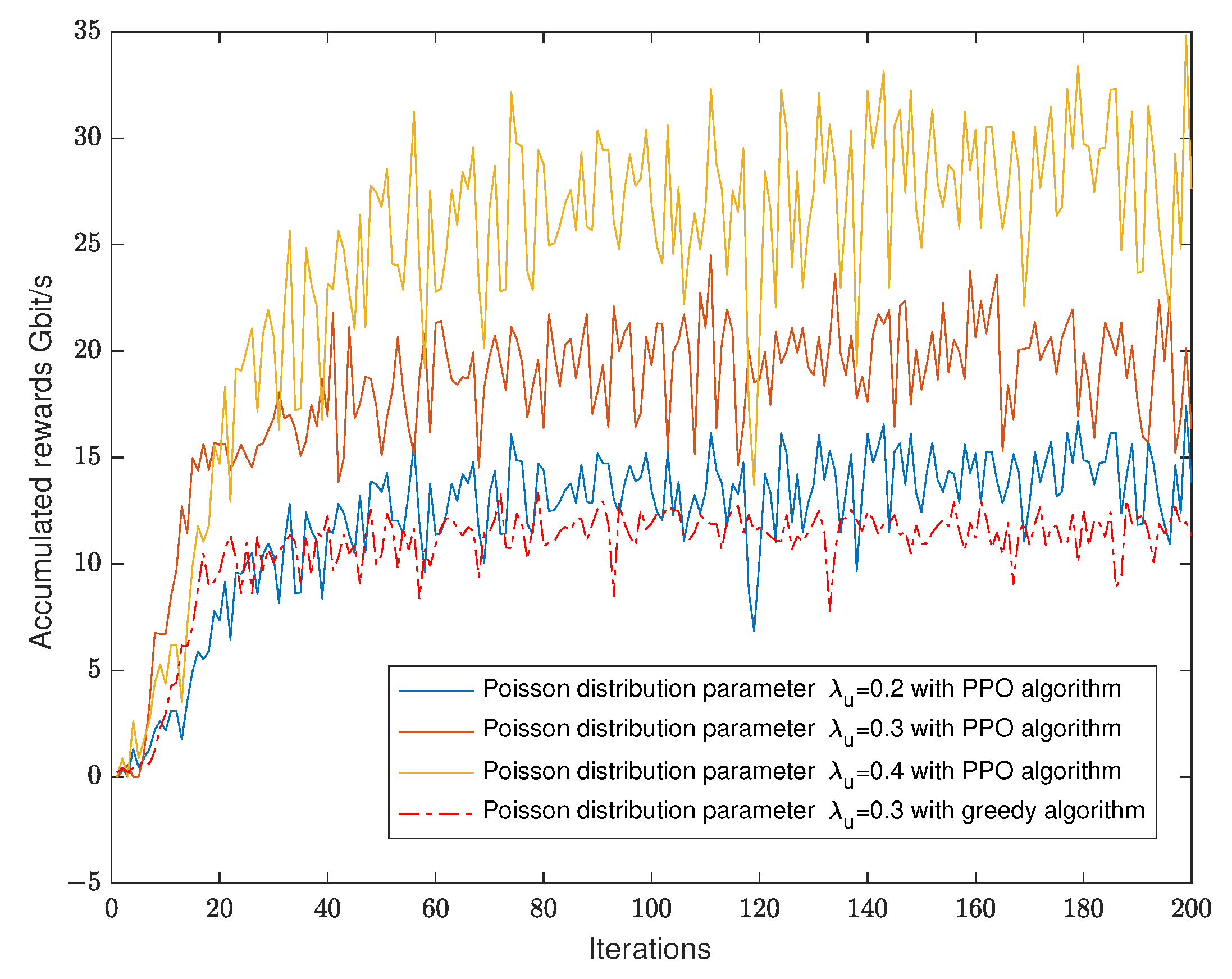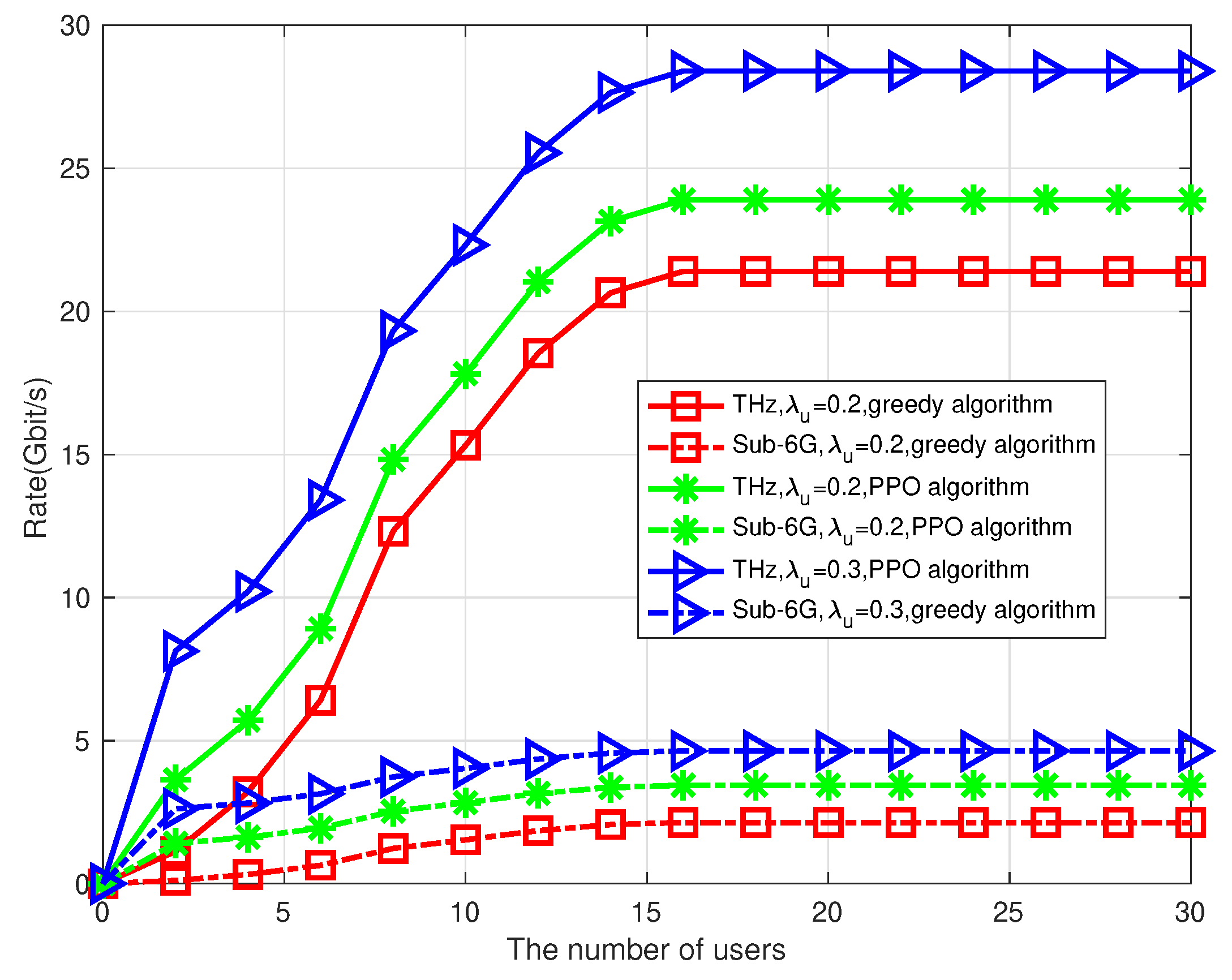UAV Trajectory Design and Power Optimization for Terahertz Band-Integrated Sensing and Communications
Abstract
1. Introduction
- •
- Designing a new sensing and communication power optimization method that considers interference between sensing and communication signals in a THz sensing-assisted UAV communication network.
- •
- Formulating an optimization problem (Figure 1) and proposing an efficient alternative optimization to solve this problem. First, we use the Lagrangian dual decomposition method to obtain the power of sensing and communication with a fixed trajectory. Second, we use the policy optimization (PPO) algorithm for joint optimization of the UAV location and frequency association with a fixed power of sensing and communication.
- •
- Designing a PPO algorithm for optimizing the UAV trajectory and frequency association. The PPO algorithm uses the critic network with global information and the actor network with local information to achieve cooperation to explore the angle of UAV and the frequency association.
2. Prior Works
3. System Model and Problem Formulation
3.1. System Model
3.2. Problem Formulation
4. Problem Decomposition and Joint Optimizing Design
4.1. Problem Decomposition
4.2. Joint Optimization Design
4.2.1. Joint Sensing and Communication Power
4.2.2. Joint UAV Trajectory and Frequency Association
- •
- State: The states observed by an agent are determined by a combination of the transmission powers of sensing and communication. Thus, we define the state of a UAV at time step t as follows:
- •
- Action: The action is to choose proper flight direction and proper frequency association to obtain better rewards. Furthermore, we define the action performed in time-step t as . Let us suppose the possibility of state taking action at time-step t is , where is the probability density function with parameter . The action is denoted by the all possible actions at time step t, i.e., .
- •
- Reward: The agent receives an immediate reward, denoted as , which describes its benefit from taking action . Thus, the function of reward can be written as:where is the discount rate, which determines the effect of future rewards on the current action. means that the reward value of the future state has a great influence on the action state function, while means that the reward value of the future state has little influence on the action state function.
4.3. Computational Complexity
| Algorithm 1 The Proximal Policy Optimization Algorithm |
| Algorithm 2 The Proposed Alternating Optimization Algorithm to Solve Problem (12) |
|
5. Simulation Results
6. Conclusions
Author Contributions
Funding
Institutional Review Board Statement
Informed Consent Statement
Data Availability Statement
Conflicts of Interest
Appendix A
References
- Zhang, L.; Zhao, H.; Hou, S.; Zhao, Z.; Xu, H.; Zhang, R. A Survey on 5G Millimeter Wave Communications for UAV-Assisted Wireless Networks. IEEE Access 2019, 7, 117460–117504. [Google Scholar] [CrossRef]
- Andrews, J.G.; Buzzi, S.; Choi, W.; Hanly, S.V.; Lozano, A.; Soong, A.C.K.; Zhang, J.C. What will 5G be? IEEE J. Sel. Area in Comm. 2014, 32, 1065–1082. [Google Scholar] [CrossRef]
- Sarieddeen, H.; Saeed, N.; Al-Naffouri, T.Y.; Alouini, M.-S. Next generation terahertz communications: A rendezvous of sensing, imaging, and localization. IEEE Commun. Mag. 2020, 58, 69–75. [Google Scholar] [CrossRef]
- Zhang, Z.; Xiao, Y.; Ma, Z.; Xiao, M.; Ding, Z.; Lei, X.; Karagiannidis, G.K.; Fan, P. 6G wireless networks: Vision, requirements, architecture, and key technologies. IEEE Veh. Technol. Mag. 2019, 14, 28–41. [Google Scholar] [CrossRef]
- Liu, A.; Huang, Z.; Li, M.; Wan, Y.; Li, W.; Han, T.X.; Liu, C.; Du, R.; Tan, D.K.P.; Lu, J.; et al. A Survey on Fundamental Limits of Integrated Sensing and Communication. IEEE Commun. Surv. Tutor. 2022, 24, 994–1034. [Google Scholar] [CrossRef]
- Liu, F.; Cui, Y.; Masouros, C.; Xu, J.; Han, T.X.; Eldar, Y.C.; Buzzi, S. Integrated Sensing and Communications: Toward Dual-Functional Wireless Networks for 6G and Beyond. IEEE J. Sel. Areas Commun. 2022, 40, 1728–1767. [Google Scholar] [CrossRef]
- Zhang, J.; Fei, Z.; Wang, X.; Liu, P.; Huang, J.; Zheng, Z. Integrated Scheduling of Sensing, Communication, and Control for mmWave/THz Communications in Cellular Connected UAV Networks. IEEE J. Sel. Areas Comm. 2022, 40, 2103–2113. [Google Scholar]
- Zhang, L.; Wang, Y.; Min, M.; Guo, C.; Sharma, V.; Han, Z. Privacy-Aware Laser Wireless Power Transfer for Aerial Multi-Access Edge Computing: A Colonel Blotto Game Approach. IEEE Internet Things 2022, 15, 2327–4662. [Google Scholar] [CrossRef]
- Wang, X.; Wang, P.; Ding, M.; Lin, Z.; Lin, F.; Vucetic, B.; Hanzo, L. Performance Analysis of Terahertz Unmanned Aerial Vehicular Networks. IEEE Trans. Veh. Technol. 2020, 69, 16330–16335. [Google Scholar] [CrossRef]
- Griffiths, H.; Cohen, L.; Watts, S.; Mokole, E.; Baker, C.; Wicks, M.; Blunt, S. Radar spectrum engineering and management: Technical and regulatory issues. Proc. IEEE 2015, 103, 85–102. [Google Scholar] [CrossRef]
- Roberton, M.; Brown, E.R. Integrated radar and communications based on chirped spread-spectrum techniques. IEEE MTT-S Int. Microw. Symp. Dig. 2013, 1, 611–614. [Google Scholar]
- Lin, Z.; Lin, M.; de Cola, T.; Wang, J.; Zhu, W.; Cheng, J. Supporting IoT With Rate-Splitting Multiple Access in Satellite and Aerial-Integrated Networks. IEEE Internet Things J. 2021, 8, 11123–11134. [Google Scholar] [CrossRef]
- Yuan, Z.; Yang, Y.; Wang, D.; Ma, X. Energy-Efficient Trajectory Optimization for UAV-Enabled Cellular Communications Based on Physical-Layer Security. Aerospace 2022, 9, 50. [Google Scholar] [CrossRef]
- Lan, T.; Qin, D.; Sun, G. Joint Optimization on Trajectory, Cache Placement, and Transmission Power for Minimum Mission Time in UAV-Aided Wireless Networks. ISPRS Int. J. Geo-Inf. 2021, 10, 426. [Google Scholar] [CrossRef]
- Ko, Y.; Kim, J.; Duguma, D.G.; Astillo, P.V.; You, I.; Pau, G. Drone Secure Communication Protocol for Future Sensitive Applications in Military Zone. Sensors 2021, 21, 2057. [Google Scholar] [CrossRef]
- Krichen, M.; Adoni, W.Y.H.; Mihoub, A.; Alzahrani, M.Y.; Nahhal, T. Security Challenges for Drone Communications: Possible Threats, Attacks and Countermeasures; SMARTTECH: Riyadh, Saudi Arabia, 2022; pp. 184–189. [Google Scholar]
- Li, Q.; Nayak, A.; Zhang, Y.; Yu, F.R. A Cooperative Recharging-Transmission Strategy In Powered UAV-Aided Terahertz Downlink Networks. IEEE Trans. Veh. Technol. 2022, 1939–9359. [Google Scholar] [CrossRef]
- Xu, L.; Chen, M.; Chen, M.; Yang, Z.; Chaccour, C.; Saad, W.; Hong, C.S. Joint Location, Bandwidth and Power Optimization for THz-enabled UAV Communications. IEEE Commun. Lett. 2021, 25, 1984–1988. [Google Scholar] [CrossRef]
- Raza, A.; Ijaz, U.; Ishfaq, M.K.; Ahmad, S.; Liaqat, M.; Anwar, F.; Iqbal, A.; Sharif, M.S. Intelligent reflecting surface-assisted terahertz communication towards B5G and 6G: State-of-the-art. Microw. Opt. Technol. Lett. 2022, 64, 858–866. [Google Scholar] [CrossRef]
- Chiriyath, A.R.; Paul, B.; Bliss, D.W. Radar-Communications Convergence: Coexistence, Cooperation, and Co-Design. IEEE Trans. Cogn. Commun. Netw. 2017, 3, 1–12. [Google Scholar] [CrossRef]
- Zheng, L.; Lops, M.; Wang, X.; Grossi, E. Joint Design of Overlaid Communication Systems and Pulsed Radars. IEEE Trans. Signal Process. 2018, 66, 139–154. [Google Scholar] [CrossRef]
- Chiriyath, A.R.; Paul, B.; Jacyna, G.M.; Bliss, D.W. Inner Bounds on Performance of Radar and Communications Co-Existence. IEEE Trans. Signal Process. 2015, 64, 464–474. [Google Scholar] [CrossRef]
- Lin, Z.; Niu, H.; An, K.; Wang, Y.; Zheng, G.; Chatzinotas, S.; Hu, Y. Refracting RIS-Aided Hybrid Satellite-Terrestrial Relay Networks: Joint Beamforming Design and Optimization. IEEE Trans. Aerosp. Electron. Syst. 2022, 58, 3717–3724. [Google Scholar] [CrossRef]
- Lin, Z.; An, K.; Niu, H.; Hum, Y.; Hu, Y.; Chatzinotas, S.; Zheng, G.; Wang, J. SLNR-based Secure Energy Efficient Beamforming in Multibeam Satellite Systems. IEEE Trans. Aerosp. Electron. Syst. 2022, in press. [CrossRef]
- Wang, Y.; Chen, M.; Pan, C.; Wang, K.; Pan, Y. Joint Optimization of UAV Trajectory and Sensor Uploading Powers for UAV-Assisted Data Collection in Wireless Sensor Networks. IEEE Interent Things 2022, 9, 11214–11226. [Google Scholar] [CrossRef]
- Lin, Z.; Lin, M.; Wang, J.; de Cola, T.; Wang, J. Joint Beamforming and Power Allocation for Satellite-Terrestrial Integrated Networks With Non-Orthogonal Multiple Access. IEEE J.-STSP 2019, 13, 657–670. [Google Scholar] [CrossRef]
- Zhang, L.; Ma, X.; Zhuang, Z.; Xu, H.; Sharma, V.; Han, Z. Q-Learning Aided Intelligent Routing with Maximum Utility in Cognitive UAV Swarm for Emergency Communications. IEEE Trans. Veh. Technol. 2022, in press. [Google Scholar] [CrossRef]
- Han, C.; Bicen, A.O.; Akyildiz, I.F. Multi-Ray Channel Modeling and Wideband Characterization for Wireless Communications in the Terahertz Band. IEEE Trans. Wirel. Commun. 2015, 14, 2402–2412. [Google Scholar] [CrossRef]
- Zhang, L.; Zhang, H.; Guo, C.; Xu, H.; Song, L.; Han, Z. Satellite-Aerial Integrated Computing in Disasters: User Association and Offloading Decision. In Proceedings of the 2020 IEEE International Conference on Communications (ICC), Dublin, Ireland, 7–11 June 2020; pp. 554–559. [Google Scholar]







| [12,13,14,15,16] | [17,18,19] | [20,21,22] | [23,24,25,26] | Our Work | |
|---|---|---|---|---|---|
| THz Frequency | × | ✔ | × | ✔ | ✔ |
| UAVs Communication | ✔ | ✔ | × | × | ✔ |
| Power Optimization | ✔ | × | × | ✔ | ✔ |
| Integrated Sensing and Communication | × | × | ✔ | × | ✔ |
| UAV Trajectory Design | ✔ | ✔ | × | ✔ | ✔ |
| Parameter | Value | Parameter | Value |
|---|---|---|---|
| Time, T | 20 s | A-BS Height, H | 5 m |
| Time slot, | 1 ms | ABS Speed, V | [0,3] m/s |
| Noise power, | −20 bBm | Reference pressure, | 101.325 kPa |
| Reference temperature, | 20 | Maximum sensing transmission power, | 30 dBm |
| Maximum communication transmission power, | 30 dBm | Discount rate, | 0.1 |
Disclaimer/Publisher’s Note: The statements, opinions and data contained in all publications are solely those of the individual author(s) and contributor(s) and not of MDPI and/or the editor(s). MDPI and/or the editor(s) disclaim responsibility for any injury to people or property resulting from any ideas, methods, instructions or products referred to in the content. |
© 2023 by the authors. Licensee MDPI, Basel, Switzerland. This article is an open access article distributed under the terms and conditions of the Creative Commons Attribution (CC BY) license (https://creativecommons.org/licenses/by/4.0/).
Share and Cite
Gao, Y.; Xue, H.; Zhang, L.; Sun, E. UAV Trajectory Design and Power Optimization for Terahertz Band-Integrated Sensing and Communications. Sensors 2023, 23, 3005. https://doi.org/10.3390/s23063005
Gao Y, Xue H, Zhang L, Sun E. UAV Trajectory Design and Power Optimization for Terahertz Band-Integrated Sensing and Communications. Sensors. 2023; 23(6):3005. https://doi.org/10.3390/s23063005
Chicago/Turabian StyleGao, Ying, Hongmei Xue, Long Zhang, and Enchang Sun. 2023. "UAV Trajectory Design and Power Optimization for Terahertz Band-Integrated Sensing and Communications" Sensors 23, no. 6: 3005. https://doi.org/10.3390/s23063005
APA StyleGao, Y., Xue, H., Zhang, L., & Sun, E. (2023). UAV Trajectory Design and Power Optimization for Terahertz Band-Integrated Sensing and Communications. Sensors, 23(6), 3005. https://doi.org/10.3390/s23063005






